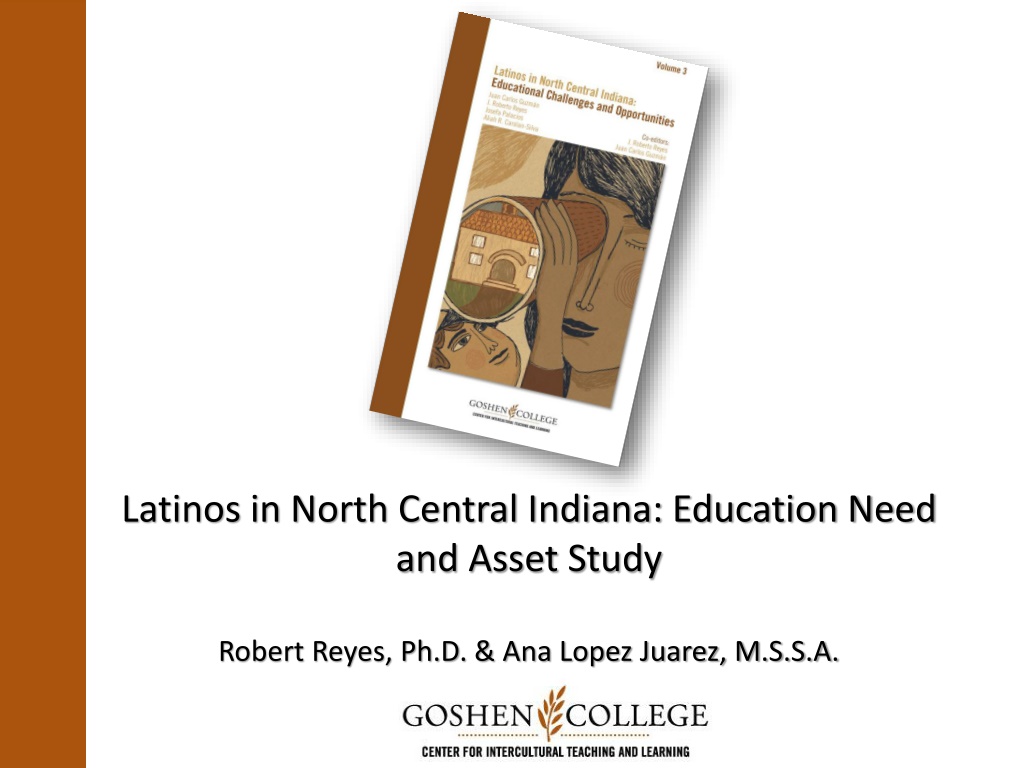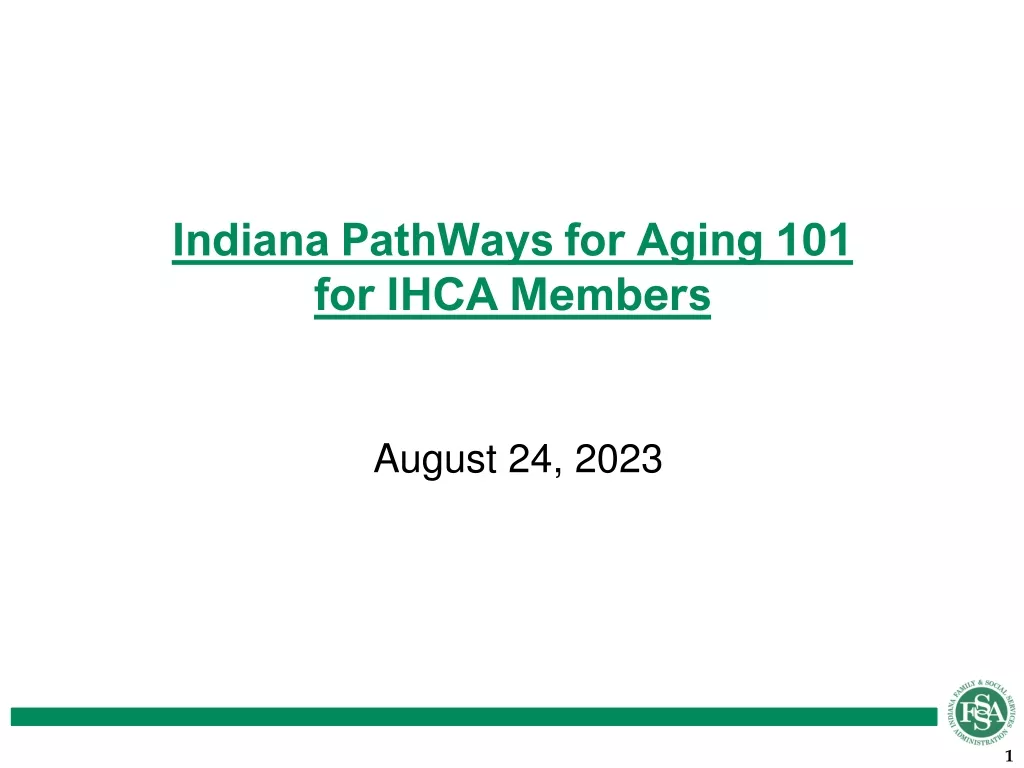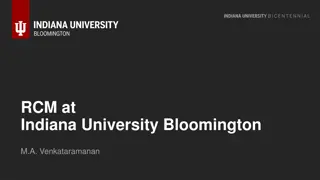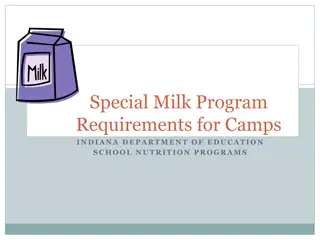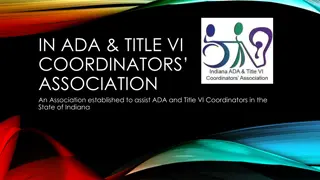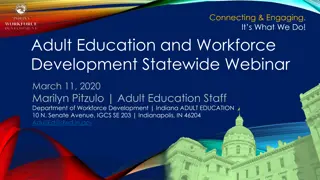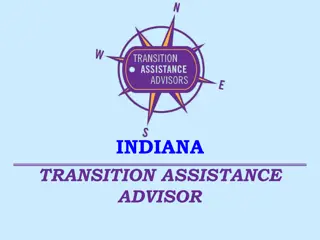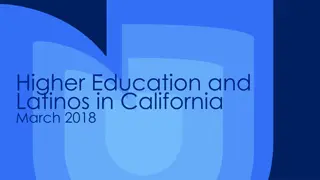Latinos in North Central Indiana: Education Study
Latinos in North Central Indiana are the focus of an educational need and asset study, exploring the relationships and support networks that influence academic success. The research delves into theoretical underpinnings, social capital theory, and the impact of social relationships on student achievement. Methodologies include qualitative interviews with students, parents, and educators to gain insights into the factors shaping Latino students' educational experiences.
Download Presentation

Please find below an Image/Link to download the presentation.
The content on the website is provided AS IS for your information and personal use only. It may not be sold, licensed, or shared on other websites without obtaining consent from the author.If you encounter any issues during the download, it is possible that the publisher has removed the file from their server.
You are allowed to download the files provided on this website for personal or commercial use, subject to the condition that they are used lawfully. All files are the property of their respective owners.
The content on the website is provided AS IS for your information and personal use only. It may not be sold, licensed, or shared on other websites without obtaining consent from the author.
E N D
Presentation Transcript
Latinos in North Central Indiana: Education Need and Asset Study Robert Reyes, Ph.D. & Ana Lopez Juarez, M.S.S.A.
Outline for the Session Overview of CITL at Goshen College The Need and Asset Study Research Goals Theoretical Underpinnings & Methodology Findings Secondary Data & Qualitative Interviews Recommendations
Research Questions Questions on demographic data-- What factors facilitate or impede the relationships between students and their social networks inside and outside of school? What are the sources of support social networks provide and the challenges to they face in providing support to students? How do Latino students social networks (inside and outside of school) contribute to their academic success?
Theoretical Underpinnings Family, community, school as three spheres of student s lives. Support of student development and achievement depends on connection between spheres (Epstein, 1995). Socio-cultural processes & and structures mediate ways families and communities participate and share responsibility (Auerbach2007; Lareau 2000). Social Capital Theory: Refers to social relationships from which an individual is potentially able to derive institutional support, particular that includes the delivery of knowledge-based resources, for example, guidance for college admission. (Brykand Schneider 2002, Dodd and Konzal2002, Oakes et al. 2000).
Influence of Social Capital on Student Success Family (parents, siblings, extended) Community (church, youth group, nonprofits, etc.) Student Success Peers School (teachers, counselors, system)
Methodology (General Students) **Expand- Separate Methods and Sample Qualitative Methodology Focus groups with 36 students (9 in each city: Goshen, Elkhart, South Bend, Ligonier) Focus groups with 24 parents (6 in each city) Semi-structured interviews with 15 educators ( about 4 in each city)
Methodology (Study with High Achieving Students) Interviews with 25 college-bound (various achievement levels), Junior and Senior Latino students, 2009-2011 Interviews with school teachers and staff Observations of classrooms and school events Semi-structured interviews: 40 minutes to 1.5 hours Discussed topics such as: college preparation process, development of aspirations, resources that supported them during process, challenges they faced, overall experiences in school Instrumental Case Study Approach: Select high achieving Latina students who faced and overcame significant barriers
Introduction: Demographic / Educational Context
Population by Race/Ethnicity: Elkhart, Noble, and St. Joseph Counties, 2009 250 208 200 154 Estimated population 150 Whites remain the majority. Latinos are next significant minority in Elkhart and Noble counties (in thousand 100 42 50 32 30 17 11 10 6 6 1 0 0 Elkhart Noble St. Joseph White Black Latino Other
Latino Share of the Population: Elkhart, Noble, and St. Joseph Counties, 1970-2009 16% 15.1% 14% 11.5% 12% 10% Most of Latino population growth took place in the 1990s and continued into the 2000s but growth slowed 8.9% 8% 7.1% 6.5% 6% 4.7% 4% 2.1% 1.9% 1.7% 1.3% 1.5% 2% 1.0% 0.9% 0.9% 0.0% 0% 1970 1980 1990 2000 2009 Elkhart Noble St. Joseph
Latino Population, by Age and Nativity: Elkhart, Noble, and St. Joseph Counties, 2009 18,000 16,000 Growth in this area has been mostly from foreign-born Latinos who then have children here Counties with less US-born children signal a settled population with less recent migrants 14,000 12,000 10,000 8,000 6,000 4,000 2,000 0 Elkhart Noble St. Joseph Elkhart Noble St. Joseph Elkhart Noble St. Joseph Children (under 18) Adults (18+) Total US-born Foreign-born
Distribution of Latino and Non-Latino Workers, by Industry: Elkhart and St. Joseph Counties, 2006-2008 70% 49% 60% 50% 37% 45% 30% 40% 34% 34% 30% 25% 16% 20% 11% 10% 9% 7% 7% 10% 4% 0% Elkhart St. Joseph Latino Non-Latino In both Elkhart and St. Joseph counties, manufacturing and services employed more Latinos and non-Latinos than any industry In Elkhart County, a large majority of Latinos are employed in manufacturing and 30 percent are in services
Ethnicity of School Corporations by Percentage 70% 60.6% 60% 54.5% White is the most common ethnicity, followed by Hispanic in all districts except South Bend, where Black is the second most common ethnicity. 51.5% 51.2% 50% 43.2% 39.1% 37.2% 40% 34.2% 30% 23.4% 20.1% 20% 16.4% Concord is the least ethnically diverse school system and South Bend is the most ethnically diverse. 15.6% 9.5% 10% 1.7% 0.00% 0% Black Hispanic White
Free and Reduced Meal Population by Percent There are more students receiving financial assistance for meals than not in every district. 70% 59.8% 58.2% 60% 56.3% 56.0% 50% 45.9% 42.7% 38.1% 40% Concord has the highest rate of students who are able to pay full price, and South Bend has the lowest. Concord also has the lowest rate of ethnic diversity and the second lowest rate of English Language Learners. 33.7% 33.5% 31.5% 30% 20% 11.9% 11.4% 10.3% 8.7% 8.3% 10% 0% South Bend has the highest rate of students receiving free meals. It is also the most ethnically diverse and has the lowest proportion of English Language Learners. Free Meal Reduced Price Meal Full price meal
Percentage of Students who are English Language Learners 100% 88% South Bend has the lowest rate of English Language Learners. 84% 90% 82% 80% 72% 68% 70% West Noble has the highest. 60% 50% 40% 32% 28% 30% 18% 16% 20% 12% 10% 0% English Language Learners Non English Language Learners
Hispanic Diploma Achievement by Percent 70% 62.7% In general, it is most common for Hispanic students to achieve the Core 40 diploma, which is the lowest diploma commonly accepted by colleges. Very few Hispanic students achieve the Honors diploma, which is the highest diploma offered by most Indiana schools. 60% 53.7% 52.0% 50.0% 47.9% 50% 39.6% 40.0% 40% 36.1% 31.0% 30% 27.5% 17.5% 20% 12.5% 10.2% 7.1% 10% 6.0% Goshen has the lowest rate of Hispanic students achieving Honors diplomas. 0% Concord has the highest rate of Hispanic students achieving honors diplomas. Core 40 General Honors
High School Graduation Rates in Selected School Districts, by Race/Ethnicity: Elkhart, Noble, and St. Joseph Counties, 2008-2009 100% 93% 90% 85% 82% 80% In all but one of the local school organizations, Latinos graduated at a lower rate than whites Noble County is the exception, with a Latino graduation rate close to that of white students South Bend s gap between Latino and white student graduation rates (14 percentage points) is comparable to that of the state (14.6 percentage points) but in Elkhart County the gap is higher (23 and 19 percentage points) 77% 77% 80% 75% 70% 63% 59% 58% 60% 50% 40% 30% 20% 10% 0% Concord Community Schools Elkhart Community Schools Goshen Community Schools South Bend Community School Corporation West Noble School Corporation White Latino
Results: Qualitative Findings
Influence of Social Networks on Student Success Family (parents, siblings, extended) Community (church, youth group, nonprofits, etc.) Student Success Peers School (teachers, counselors, system)
Impact of Peer Networks on Student Success Factors that Impede Relationships Factors that Facilitate Positive Relationships US-born Latinos feel welcomed and comfortable in schools. It is difficult socially for foreign-born students at school. (Culture, English speaking ability) US-born Latinos have friends from different ethnicities. Cultural differences between newly arrivals and old timers/U.S. born.
Impact of Peer Networks on Student Success (High Achieving Students) Factors that Facilitate Positive Relationships Involved in supportive peer groups
Impact of Peer Networks on Student Success (High Achieving Students) My friends are like, I told them, I don t think I m going to college and my parents don t care [if I go] and they were like Are you serious? You re not going to college? You are an honors student! It s not like you are another student and it s like yeah so what does it matter? And they re like how can you say it doesn t matter?...you re doing college-based courses and she was like no, you have to go, you have to go so it s like okay, if you can do it, then I can do it
Impact of Peer Networks on Student Success The second, third generation is already involved in a lot of the activities that the school provides. Their circle of friends is different than our first generation who are just beginning to know the language, who are beginning to note things, what to join and what not to join. (Educator, Elkhart)
Impact of Peer Networks on Student Success Unfortunately, many times the second-generation students would kind of put down the first-generation students. They felt like, We've been here longer. We know what's going on. You guys are new. And they would pick on them or put them down. So for me that s sad. To see people who'd been here longer not accept the people who had just come recently. (Educator, Ligonier)
Influence of Social Networks on Student Success Family (parents, siblings, extended) Community (church, youth group, nonprofits, etc.) Student Success Peers School (teachers, counselors, system)
Impact of Teachers & Staff (i.e., Institutional Agents) on Student Success Factors that impede relationships Perception that teachers don t know how to relate Factors that facilitate positive relationships Teachers who know their siblings Teachers who are also Latino/bilingual Teachers who have similar interest in a subject Teachers who have more patience Feelings of isolation
Impact of Teachers & Staff (i.e., Institutional Agents) on Student Success (High Achieving Students) Factors that Facilitate Positive Relationships Multiple, strong relationships within family and school
Impact of Educational System on Student Success Latinos don t take as many college prep classes English ability is a barrier to be prepared for college Lack of access to information about college
Impact of Institutional Agents on Student Success She shares where she went on vacation or what she did or she asks me what I am up to or how my family is. And you see it is a confidence the two of [us] share. She knew my brother in school. I never had her as a teacher. Rather, through my brother I knew she got along well with him. I started to spend time with her and I realized that she was a good person, and then I had confidence in her. (Latino student, Goshen)
Impact of Institutional Agents on Student Success I would also go with Miss X primarily because she is Latina. I think she knows how we feel and we trust her. She is the one who helps us with everything, in whatever problem we have. (Latino student, Goshen)
Impact of Institutional Agents on Student Success [I go to] the professors of the subjects that interest me, like science. I trust them if I have a problem. They are American, but there have been instances where I have not understood something and I go [to them]. (Latino student, Goshen)
Impact of Institutional Agents on Student Success Sometimes there are teachers who are more patient than others and they sit with you and they explain it to you. Sometimes they stay after class to help you if you need more help, but there are others that won t. (Latino student, Elkhart)
Impact of Institutional Agents on Student Success We can go to the professors. They can explain [it] to us but they don t feel as secure as the other professors who speak Spanish with us because they do understand what we don t understand and they understand how we feel. (Latino student, Elkhart)
Impact of Institutional Agents on Student Success It has happened around two times that they leave us alone in the corner and they let us off easy at the start of class. Later they will give me help because I am Latino and I don t understand the material very well. (Latino student, Goshen)
Impact of Institutional Agents on Student Success (High Achieving Students) My home room teacher I was the only honors student in his class and he was like you guys [other students] should follow her lead .it was really nice to feel like that, to feel that somebody actually cared about what you were doing. And that makes you feel really happy and like you want to do good things so they approve I want to go to college and he is like helping me, he is always like have you filled out your applications, scholarships and all this he s been a big motivation. I am really thankful.
Impact of Educational System on Student Success The high school in general offers courses, the AP exams, honors courses, clubs, because colleges look at students overall: how they're doing, not only academically, but in the community. I think the high school offers all of that. We just have to get our students in there . . . . We have a lot of Latinos in the regular classes. Let's get them . . . higher. (Educator, Goshen)
Impact of Educational System on Student Success It depends on when they entered our system. A student who arrives here speaking little or no English in junior high or high school is not going to be as prepared for success at an English-speaking college as the student who was born here and attends our school all those years. (Educator, Elkhart)
Impact of Educational System on Student Success That s a problem. [Counselors] give the information to [students] and sometimes . . . you have to fish for information hoping to catch something, and I see a problem with that. When they are in tenth or eleventh grade they get all the information and they only talk to you when they miss something, when they are late, and something like that, and they don t give all the information to you . . . because they aren t worried about money. . . . They are worried about their classes, their levels, but not about where they are going, how would they support themselves, and I say that that is in part because you don t ask for information, and they won t give it to you. (Latino parent, Elkhart)
Influence of Social Networks on Student Success Family (parents, siblings, extended) Community (church, youth group, nonprofits, etc.) Student Success Peers School (teachers, counselors, system)
Influence of Parent Involvement on Student Success Sources of Support Providing Moral Support Barriers for Support Limited school exposure Lack of knowledge of the educational system Being a provider Language proficiency Monitoring Behavior
Influence of Parent Involvement on Student Success (High Achieving Students) Maintain high expectations despite limits in other forms of support Education as the ONLY option for the future Strong source of emotional and moral support Religious faith
Influence of Parent Involvement on College Access Sources of Support Support and motivation from families Barriers to Support Parents don t understand college experience and college choice process Students motivated by parents stories Female social pressure to start own family.
Influence of Parent Involvement on Student Success Moral Support: I told them that they have to see that we make big efforts so they can [have this education], because maybe we don't have a lot of studies but we want them to be better. (Latino parent, Ligonier)
Influence of Parent Involvement on Student Success Being a Provider: To me, as a mother, it s important to provide them with the educational materials that they are required to have. Sometimes it s complicated because I don t have money to buy them and I don t know what to do because if they don t bring them they are going to get behind compared to other children. And they have the capability to do the work, but if you as a parent say, They need this for tomorrow, but I m going to leave it until Friday because I get paid that day, your kid is going to get behind, not because of his capabilities. You as a parent have to provide the educational materials that your children are asking for. (Latino Parent, Goshen)
Influence of Parent Involvement on Student Success Monitoring Behavior: My mom, she s always been on my back about everything, every single thing I ve done. It s school, friends, where I go with who, sports . . . . She goes to school, she talks to counselor, she talks to principal. I wouldn t even know but then she ll just tell me when I come home, I talked to your teacher. She s . . . in all these programs just to learn about how the school system works and I appreciate it. (Latino student, South Bend)
Influence of Parent Involvement on Student Success Limited School Exposure: I think you bring your own limitations. Because you feel, you feel less [of a person]. When you are in a group of people that are from here, I mean, they look at you like that, and you feel bad because of those limitations . . . . And you don t know. You are not useful. (Latino parent, South Bend)
Influence of Parent Involvement on Student Success Knowledge of Educational System: I spoke with parents about this . . . . Most of them are uneducated themselves. They haven t figured out how to help them yet. This is just first generation that I am talking about. They do try to encourage students to do well in school, but then again I don t [know] if they understand the concept of a D or a C. The comments on the report card are all in English. (Educator, South Bend)
Influence of Parent Involvement on Student Success Language Barrier: Language is a barrier, and sometimes teachers don t know how to communicate . . . so you have to have an interpreter so he can translate what s going on . . . . [D]uring the first years of school language was a barrier for me. I as a mother didn t know English. It was too big and if we want our children to succeed we had to learn. Now that I ve learned a little more I realize that during my first few years I didn t go to school not at all just to pick them up. No celebrations, nothing, because of the language. (Latino parent, Goshen)
Influence of Parent Involvement on Student Success Language Barrier: Because of that [not speaking English], it is like a large part of why she doesn t go [to school activities such as parent-teacher conferences]. She says because she doesn t understand and later there are bilingual teachers but they say everything wrong. (Latino student, Elkhart)
Influence of Parent Involvement on Student Success (High Achieving Students) My parents have always been supportive of education too, because they didn t really have the opportunity to go to school, so they think it s very important that we do. Even though they haven t been able to help me much with applications and all, they are still very motivated to help me in whatever way they can, and to take me to college visits. [My parents] talk to me a lot about college. What they said is mainly it is because they want me to have a better opportunity than they had and my dad attended college for a year in Mexico and he said it was really hard for him to pay and that is why he came here and my mom, she didn t go to college, she just got her high school diploma so for them it is really important for me to go to college and I am their oldest daughter so it is, I guess, they want me to be a role model for my younger siblings and I want to be a role model for them too so it is important for me.
